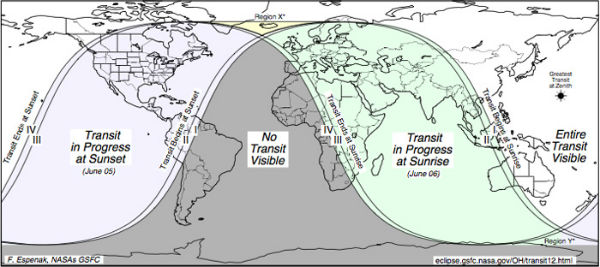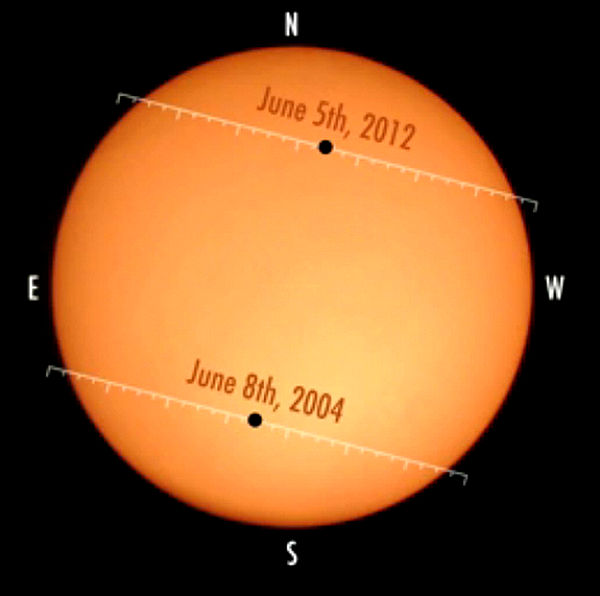2012 Transit of Venus: Quick guide for skywatchers

A transit like this occurs when Venus passes directly between Earth and the Sun. Viewers will see Venus as a small dot gliding slowly across a portion of the Sun. The last time the event occurred was on June 8, 2004, and was viewed by millions worldwide. This year, observers on six continents and a small portion of Antarctica will be in position to see at least part of it. The transit occurs from about 22:00 UTC June 5 to 05:00 UTC June 6. The exact time depends on where you are on Earth. You can see the time of transit in your area by clicking HERE.
When to watch?
Venus moves from being an evening “star” to being a morning “star” by passing in front of the Sun on June 5. Because of the International Date Line, this event will occur on Wednesday June 6 in Asia, Australia, Africa, and Europe. During this transit, an observer on Earth can track the planet Venus as it crosses the disc of the Sun. In North America the best time will be in the hours before sunset on Tuesday afternoon, June 5th. In Europe, Africa, and Australia, Venus will be in transit as the sun rises on Wednesday morning. In most of Asia and across the Pacific Ocean transit will be visible during all Wednesday.
Local transit times

 Astronomers chronicle Venus transits in terms of “contact.” First contact is when Venus first touches the outer edge of the sun. Second contact is when Venus is first entirely on the sun. Similarly, third contact is when Venus touches the sun’s edge from the inside, and fourth contact is when it is totally off the sun.
Astronomers chronicle Venus transits in terms of “contact.” First contact is when Venus first touches the outer edge of the sun. Second contact is when Venus is first entirely on the sun. Similarly, third contact is when Venus touches the sun’s edge from the inside, and fourth contact is when it is totally off the sun.
How to watch?
You can use dense filter for watching in sun direction. The only safe filters are a #14 welder’s glass or “eclipse shades glasses” available only from telescope stores and astronomy clubs. They are cheap to buy.
You can make “pinhole camera.” It can be made from a large cardboard box by making a small hole in one end of the box, about a millimeter or two in diameter. This hole acts as the lens. Place a white sheet of paper in the opposite end to serve as the viewing screen. Place the box over your head resting on your shoulders, and watch the transit on the screen. Unlike an eclipse the shadow of Venus is small and may be hard to see that way.
For those using binoculars or a small telescope, you must be aware that there is no substitute for a proper full-aperture solar filter. You must block the sunlight from entering the telescope because you run the risk of concentrating the sun’s light. Those of you who have telescopes which allow you to view the sun in hydrogen alpha light, it should be possible to see Venus silhouetted against prominences and the corona, before it moves in front of the chromosphere. If you are observing the transit with a telescope, there’s an interactive phone app that will allow you to time various parts of the transit, and which will collect the data into a repository and map it.

LIVE WEBCASTS
The primary Sun-Earth Day webcast is being hosted by NASA EDGE in Mauna Kea, Hawaii. This webcast event will run through the entirety of the transit of venus, beginning at 21:45 UTC (11:45am local Hawaiian time or 5:45pm EST).
The online Slooh Space Camera will offer a complete view of the transit of Venus from several different observatories around the world, including telescopes in Australia, japan, New Zealand, Hawaii, Norway, Arizona and New Mexico. The webcast will begin at 22:00 UTC (3 p.m. PDT , 6 p.m. EDT) and include a wide range of expert speakers from astronomy, filmmaking, science reporting and more.
The skywatching and astronomy community Astronomers Without Borders will present a live webcast of the Venus transit as it appears from the Mount Wilson Observatory high above Southern California. The webcast will include interviews with experts, amateur astronomers, video tours of the observatory and a look at vintage telescopes. Astronomer Without Borders President Mike Simmons will host the event.
San Francisco’s Exploratorium science center will offer a live webcast of the 2012 transit of Venus beamed direction from the Mauna Loa Observatory on the big island of Hawaii. The webcast will behind at 22:00 UTC (3 p.m. PDT, 6 p.m. EDT) and include an audio commentary every 30 minutes during the program.
The Coca-Cola Space Science Center at Columbus State University in Columbus, Ga., will offer a comprehensive webcast of the Venus transit from observation points in Australia, Mongolia, Utah and at home during the June 5 celestial display. The viewers will be able to see images from Alice Springs, Australia, Mongolia’s Gobi Desert and U.S. transit views from Bryce Canyon in Utah and Columbus, Ga. Photos of the skywatching gatherings and images from each site will also be available online.
The University of Arizona’s Mt. Lemmon SkyCenter in Tucson, Ariz., is expecting a sold out crowd during its special Transit of Venus reception on Tuesday. But Tucson skywatchers (and the rest of us , too) can experience the transit view from 2,791 meters (9,157 feet) up atop Mt. Lemmon vicariously via a webcast that begins at 20:00 UTC (1 p.m. PDT, 4 p.m. EDT).
Israel’s Bareket Observatory will offer live Venus transit images in a webcast on June 6 between 02:33 to 04:56 UTC (5:33 a.m. and 7:56 a.m. Israel local time, which corresponds to 10:33 p.m. EDT June 5 and 12:65 a.m. EDT June 6.
The department of Astronomy and Meteorology at the University of Barcelona will present a webcast of the Venus transit here live from the Arctic Svalbard archipelago in northern Norway.
The Kwasan Observatory’s Venus transit webcast from Japan is here.
Appalachian State University will provide live views of the Venus Transit in North America in a live webcast here from its Physics and Astronomy AstroCam Site. The webcast will begin at 22:00 UTC (6 p.m. EDT, 3) and end at 00:00 UTC (8 p.m. EDT). Eight solar telescopes with filters will be available on site for observers at the university’s Rankin Science Observatory.
The Planet Hunters project, a cooperative effort by Yale University and the citizen science project Zooniverse, will present a live Venus transit webcast here with live views from Tromsø, Norway; Sapporo, Japan; and Carins, Australia. Live commentary will be provided in English and Spanish.
The Sky Watchers Association of North Bengal (SWAN) in India will provide live views of the Venus Transit in the hydrogen-alpha range of the light spectrum. The direct link to the webcast is here.
You can also view it on the Virtual Star party Google+ page, or on Universe Today’s YouTube live feed
Featured image: English astronomer Jeremiah Horrocks is considered the first human to have witnessed a Venus transit. He concluded that existing information about planetary positions was incorrect, so he gathered his own data, allowing him to correctly predict a transit of Venus in 1639 (which Kepler had not foreseen). (Credit: NASA Goddard Space Flight Center Sun-Earth Day)

[…] Podrá encontrar una completa guía (en ingles), para la observación del evento tanto directamente como por Internet, en la siguiente página: 2012 Transit of Venus: Quick guide for skywatchers […]